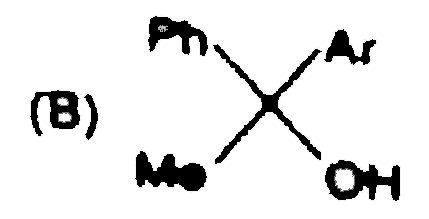Phenyl acetate (i)CH3MgBr(excess)−−−−−−−−−−−−−→(ii)H⊕'P' 'P' can be




The correct Answer is:D
To solve the problem, we will analyze the reaction of phenyl acetate with excess methylmagnesium bromide (CH3MgBr) and determine the product 'P'.
1. Identify the Reactants:
The reactant is phenyl acetate, which has the structure:
C6H5OCOCH3
and the reagent is methylmagnesium bromide (CH3MgBr).
2. Understand the Grignard Reaction:
In a Grignard reaction, the nucleophile (in this case, CH3-) attacks the electrophilic carbon of the carbonyl group in phenyl acetate. The carbonyl carbon is electrophilic due to the electronegativity of the oxygen atom.
3. Nucleophilic Attack:
The methyl group from CH3MgBr attacks the carbonyl carbon of phenyl acetate:
C6H5OCOCH3+CH3MgBr→C6H5O−(C(OH)(CH3)CH3)MgBr+
This results in the formation of a tetrahedral intermediate.
4. Protonation (Hydrolysis):
The tetrahedral intermediate is then hydrolyzed by adding water (or an acid like H+). The oxygen atom that was negatively charged becomes protonated, leading to the formation of a tertiary alcohol:
C6H5C(OH)(CH3)CH3
5. Further Reaction with Excess Grignard Reagent:
Since we have excess CH3MgBr, the alcohol can react again with another equivalent of CH3MgBr:
C6H5C(OH)(CH3)CH3+CH3MgBr→C6H5C(CH3)(C(OH)(CH3)CH3)MgBr+
This forms another tetrahedral intermediate.
6. Final Hydrolysis:
Again, hydrolysis occurs, leading to the formation of a ketone:
C6H5C(CH3)(C(OH)(CH3)CH3)+H2O→C6H5C(CH3)2+H2O
The product 'P' is thus a ketone with the structure:
C6H5C(CH3)2
Conclusion:
The product 'P' formed from the reaction of phenyl acetate with excess CH3MgBr is acetophenone.
The reactant is phenyl acetate, which has the structure:
C6H5OCOCH3
and the reagent is methylmagnesium bromide (CH3MgBr).
In a Grignard reaction, the nucleophile (in this case, CH3-) attacks the electrophilic carbon of the carbonyl group in phenyl acetate. The carbonyl carbon is electrophilic due to the electronegativity of the oxygen atom.
The methyl group from CH3MgBr attacks the carbonyl carbon of phenyl acetate:
C6H5OCOCH3+CH3MgBr→C6H5O−(C(OH)(CH3)CH3)MgBr+
This results in the formation of a tetrahedral intermediate.
The tetrahedral intermediate is then hydrolyzed by adding water (or an acid like H+). The oxygen atom that was negatively charged becomes protonated, leading to the formation of a tertiary alcohol:
C6H5C(OH)(CH3)CH3
Since we have excess CH3MgBr, the alcohol can react again with another equivalent of CH3MgBr:
C6H5C(OH)(CH3)CH3+CH3MgBr→C6H5C(CH3)(C(OH)(CH3)CH3)MgBr+
This forms another tetrahedral intermediate.
Again, hydrolysis occurs, leading to the formation of a ketone:
C6H5C(CH3)(C(OH)(CH3)CH3)+H2O→C6H5C(CH3)2+H2O
The product 'P' is thus a ketone with the structure:
C6H5C(CH3)2
The product 'P' formed from the reaction of phenyl acetate with excess CH3MgBr is acetophenone.
Topper's Solved these Questions
Similar Questions
Knowledge Check
(C2H5O)2COCH3MgBr(excess)−−−−−−−−−−−→H3O+A. A (alcohol) can also be obtained by :
ACH3CH2CHOCH3MgBr(2mol)−−−−−−−−−−→H3O+BCH3O∣∣COC2H5CH3MgBr(2mol)−−−−−−−−−−→H3O+CCH3O∣∣CCH3CH3MgBr(1mol)−−−−−−−−−−→H3O+Das in (b) and (c )Et−O−O∣∣C−O−Et(1)HC3MgBr(excess)−−−−−−−−−−−−−−→(2)H3O⊕(A), Product (A) is :
ACH3−O∣∣C−O−EtBCH3−O∣∣C−CH3CCH3−OH∣C∣CH3−CH3DCH3−CH2−CH3Compounds A and C in the following reaction are
CH3CHO(i)CH3MgBr−−−−−−−−→(ii)H2OAH2SO4.Δ−−−−−−→(B)Hydroboration oxidation−−−−−−−−−−−−−−→(C)AidenticalBpositional isomersCfunctional isomersDoptical isomers.
Ph−N=C=O(i)CH3MgBr−−−−−−−−→(ii)H2OPLiAH4−−−→Q
P and Q is
View SolutionComplete the following reaction:
CH3CH2COOHP,Br2−−−→[A](i)alc.KOH(excess)−−−−−−−−−−−−−→(ii)H+[B]
View SolutionComplete the following reaction:
CH3CH2COOHP,Br2−−−→[A](i)alc.KOH(excess)−−−−−−−−−−−−−→(ii)H+[B]
View SolutionCompounds A and C in the following reaction are
CH3CHO(i)CH3MgBr−−−−−−−−→(ii)H2OAH2SO4.Δ−−−−−−→(B)Hydroboration oxidation−−−−−−−−−−−−−−→(C)
View SolutionCompounds A and C in the following reaction are
CH3CHO(i)CH3MgBr−−−−−−−−→(ii)H2OAH2SO4.Δ−−−−−−→(B)Hydroboration oxidation−−−−−−−−−−−−−−→(C)
View Solution

